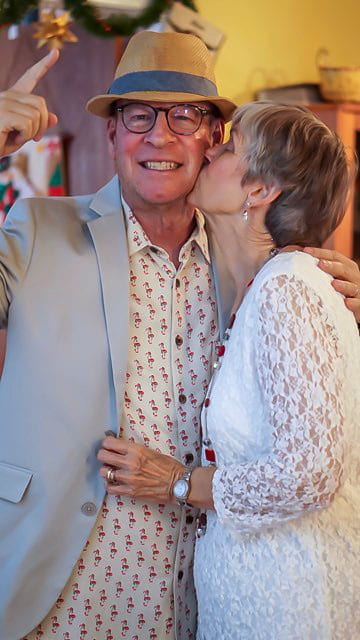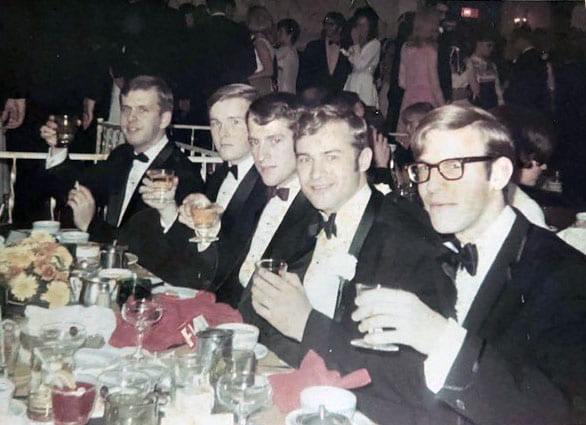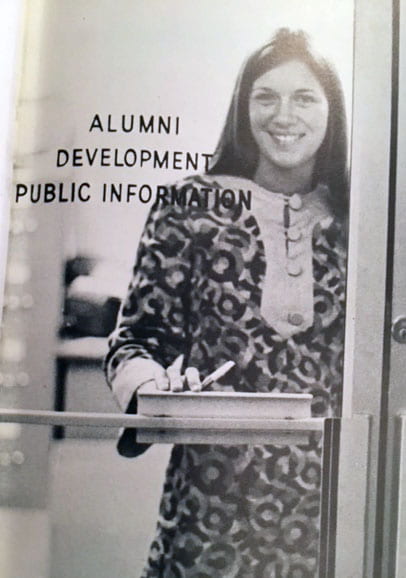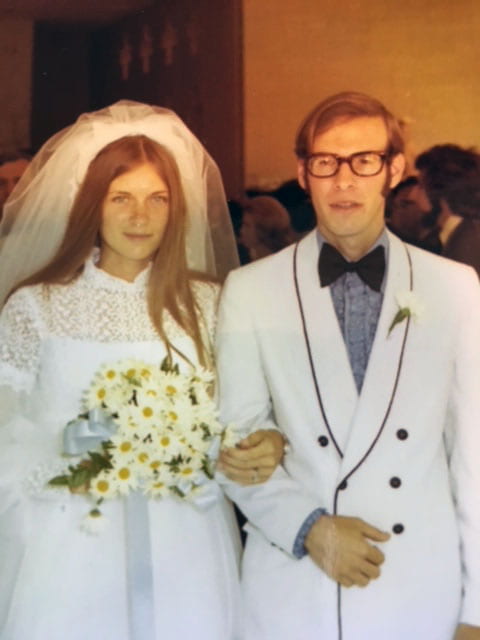Fifty years of marriage … but will we have a party?
By Roy Peter Clark ’70, ’17Hon.
I learned from my parents that longevity in a marriage does not equal bliss. “How are your parents doing?” I would be asked. “They have been married for 61 years,” I would declare,” “and have never been unhappier.” That shocked people. But it was true. Into their 80s, declining in health, they bickered like George Costanza’s parents on Seinfeld.
For the sake of this Valentine’s Day meditation, dispel the notion that longevity equals happiness. Also dispel the idea that there is such a thing as a “great” marriage. The couples who act like they have one are almost always hiding something. A good marriage is good enough. I am blessed with a pretty good one, going on 50 years.
When Karen and I tell young people that we have been married that long, their expressions show surprise. That number seems hard to imagine in a culture where every married couple has a coin flip’s chance of divorcing.
One of the documents I received in the lead-up to our 50th PC reunion, which we hope to celebrate someday, was a list of the members of the Class of 1970 who had died. I was surprised that the number exceeded 100, including classmates who were dear friends in college. I don’t know what the actuarial tables might predict for a college class a half century after graduation. Most of us are 72 years old, and that would have been a great run during the 1918 Spanish Flu pandemic.
I’ve looked at the data that indicates that many marriages end in divorce in less than a decade. What are the chances, then, that a marriage will last 50 years?
All this is prologue to a photo I found, taken in 1969, at our Ring Dance. I went with a nice girl named Diane, our only date. In the photo five of us — Gordon, Joe, Danny, Peter, and Roy — are sitting in our monkey suits, glasses raised, toasting the photographer and the world to come. When that photo turned up, something struck me. All five of us have remained married to our first wives. When I added the five other classmates with whom I remain in close touch, it applied to them as well.
As of the year 2021, here are the number of years for the 10 of us: 51, 51, 50, 50, 50, 48, 47, 47, 46, 45.
I was an English major at PC, but can add the numbers. That’s 485 years of marriage, rounded off to a solid half-millennium.

I wanted to interview my classmates and their partners in search of the “secret” ingredient. I discovered there was none. Each couple had to find their way a different way. I knew enough about my friends to understand the good lives and productive families they had built had come with significant obstacles and great suffering along the way.
In the extended Clark family, raising three daughters, we have confronted, or at least bumped into, every physical problem and social disorder imaginable. How about cancer, addiction, mental illness, the deaths of loved ones? How about being robbed at gunpoint in a motel room? How about surviving a pandemic?
I can attest that enduring these experiences, although it would destroy some marriages, has made ours stronger.
When I asked Karen if there was a virtue or behavior we had in our marriage that helped sustain us, she thought about it for a while. It wasn’t something easy and automatic, like “a good sense of humor” or “a willingness of compromise.” Those help, for sure. Her choice was “Freedom.”
In other words, neither of us had imposed our will upon the other, but rather had supported the other in our individual hopes and aspirations. I thought of at least one counterexample, where I kind of insisted, “Please do NOT write anything political on Facebook.” But that stands out as the exception.
I read an essay in a Catholic magazine years ago — I wish I could find it — written by a layman – arguing for the three necessary elements of an enduring love. I’ve memorized them and believe they apply to all kinds of marriages across generations.
- Commitment: You promise in public that you are in this for the long haul, not just trying it out to see how it goes. (I can’t help but remember an episode of “Curb Your Enthusiasm” in which Larry David and his wife renew their vows after ten years. She writes new vows in which they promise to be faithful for “all eternity.” Larry argues that “till death” was quite long enough, that he might want to pursue other options in the afterlife.)
- Intimacy: This has nothing to do with sex — yet. It involves a level of trust in which you can share with your partner your innermost hopes, dreams, and fears without dreading the consequences. Each partner needs private spaces and secrets, to be sure. But the big concerns are best shared.
- Sex: High on my list of reasons for wanting to marry Karen in 1971 was that I wanted to be with her — to touch her — every day. I wanted our intimacy to be expressed in romance and passion. I never imagined that over five decades, we would discover new expressions of fun, pleasure, release, companionship, togetherness. In spite of what popular culture might suggest, I believe the theory that well-married couples have more sex in a lifetime than the so-called “players.” What has surprised me is that while frequency might decrease, the quality can improve, a function of experience and having achieved escape velocity from raising children. Turns out that empty nesters can make love in any room in the house.
Lots of things improve a marriage, including dogs and cats. If you ask Karen who she loved more — me, or our Jack Russell terrier, Rex — on certain days she might point to the pooch. Me too.
I’m writing this during a pandemic. Karen and I have spent more time together under “house arrest” than in any year in our marriage. We both look forward to vaccinations and separate vacations. We have no idea whether we can have an anniversary party on August 7, 2021.
Every anniversary brings me back to Providence College. The Class of 1970 supported the movement toward co-education. (You’re welcome!), but we flipped our tassels just before women began taking classes in Harkins Hall.
Before that, there were women on campus, including some young women working as bookkeepers, secretaries, and clerks. Karen Major was one of them. She got a job in the Alumni Development Office, where I had a student job my senior year. She was stunning. Blue eyes, long hair, and, in the style of the day, skirts as short as a Hemingway sentence. She made them herself.
I had thick glasses and skinny legs and to this day I have no idea what she saw in me. We were married in Guzman Chapel. Rev. John Cunningham, O.P., who would become president of PC, married us. Twenty years later, we returned to the chapel where Father Cunningham help us renew our vows. Our three daughters: Alison, Emily, and Lauren were there.
In October of 2015 Karen was diagnosed with breast cancer — on the same day she received a call that her mother had died. What has followed over five years has been grueling but successful treatments: surgeries, chemotherapies, radiation treatments — followed by tremendous anxiety that the cancer will show up again. Her prognosis is good.
Nothing in my education or experience prepared me to become her caregiver. Except, maybe, for one thing. “How do you do it?” a friend asked. “I took a vow,” I said.
The more I think about it, the traditional vows get it mostly right: in good times and bad, for richer or poorer, in sickness and in health …
To my young brothers and sisters of Providence College, I leave you with this thought. Karen and I were married when she was 21 and I was 23. One year later, we were parents. You will probably wait a lot longer than we did before you marry, if you do decide to take that step. The norms that governed our marriage have shifted in so many ways, some good, some bad. But the path to enduring love and respect remains the same: commitment, intimacy, passion — and maybe a dog named Rex.
Roy Peter Clark ’70, ’17Hon. is the retired senior scholar at The Poynter Institute, a journalism school in St. Petersburg, Fla., and has written or edited 18 books, including Writing Tools: Fifty Essential Strategies for Every Writer (Little, Brown and Company, 2006). He graduated as his class salutatorian, earned a Ph.D. in English from Stony Brook University in 1974, and presented the Commencement address for the Class of 2017.








